Combating Racism – Statue of Freedom
A year ago this past week, the U.S. Capitol was the site of an insurrection against our democracy. But the U.S. Capitol has been a landmark for White supremacy since its founding. The Capitol was built and designed by those who believed in White supremacy.
BACKGROUND
On July 16, 1790, Congress declared the city of Washington in the District of Columbia, the permanent capital of the United States. The city was carved out of land donated by Maryland and Virginia, states that were slave holding at that time.
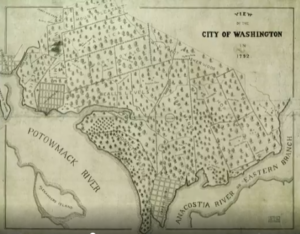
During the late 1790’s and early 1800’s, the city of Washington was being built from scratch. Founding fathers like George Washington and Thomas Jefferson thought that the new capital needed to represent the new republic, harkening back to classical places like Athens and Rome, and it needed to impress not only its own citizens but also foreign dignitaries.
So construction of the Capitol building began in 1793, when President George Washington laid the cornerstone to the north wing of the building. The city was little more than dirt roads. Skilled labor was hard to find or attract to the fledgling city. Stone was scare, brick was scarce. The only thing in abundance in the area was slave labor.
Slaves were housed in huts half way between the Capitol and the White House. They would walk in chains to their appointed workplaces down streets that had just been laid out. First they would dig the foundation trenches, then quarry the stone, bring it to the site on Capitol Hill, then lay the stone in the trenches. Then came brick makers, the work of slave women and children. About 5000 bricks were made per day.
~ ~ ~ ~ ~ ~ ~ ~ ~ ~ ~ ~ ~ ~ ~ ~ ~ ~ ~ ~ ~ ~ ~ ~ ~ ~ ~ ~ ~ ~
The first bronze sculpture made in America, was made by a slave, Phillip Reid, working with his enslaver, Clark Mills. The statue of President Andrew Jackson on a horse at the Battle of New Orleans still stands in Lafayette Park across from the White House. The statue has been the subject of much controversy of late and Washington, D.C. Delegate to Congress, Eleanor Holmes Norton, has introduced legislation to remove Jackson’s statue from the park, which once was the site of slave auctions.

Born around 1820, Reid was an enslaved laborer in the foundry run by the self-taught sculptor, Clark Mills. Mills had purchased Reid in Charleston, South Carolina for $1,200 “because of his evident talent for the [foundry] business.” Mills brought Reid with him when he moved to Washington in the late 1840’s when he won the competition for the equestrian statue of Andrew Jackson commissioned for Lafayette Park.
In order to construct the Jackson statue, a temporary foundry was erected south of the White House and, through trial and error, Mills, Reid and other workmen produced the first bronze statue ever cast in America. The accomplishment was extraordinary due to the absence of any formal training of any of the participants.
In 1860, the success of the Jackson statue prompted the secretary of war to give Mills the commission for casting the Statue of Freedom for the top of the Capitol’s new dome. A financial agreement was reached whereby the government would rent Mills’ foundry, pay him $400 a month for his services and pay for necessary materials and labor.
One of Mills’ most valued assistants working on the Statue of Freedom was his highly skilled slave, Phillip Reid, whom he described as “an expert and admirable workman.” As an enslaved worker Reid was paid directly for his work on Sundays; his owner received the payment for his work the other six days. Reid worked most weeks without a break between July 1, 1860, and May 16, 1861. Over that period, he was paid $41.25 for 33 Sundays at $1.25 per day, for “Keeping up fires under the molds.” There are no known images of Reid, who was unable to read or write.
~ ~ ~ ~ ~ ~ ~ ~ ~ ~ ~ ~ ~ ~ ~ ~ ~ ~ ~ ~ ~ ~ ~ ~ ~ ~ ~ ~ ~ ~
THE STATUE OF FREEDOM
In 1854, American sculptor Thomas Crawford was at work in his studio in Rome when he was commissioned to design the Statue of Freedom to sit atop the Capitol Dome. He invoked the goddesses Minerva and Athena and his design included a liberty cap, the ancient Roman symbol of an emancipated slave. The liberty cap originated in ancient Rome where it was given to newly-freed people during their ceremony of emancipation.
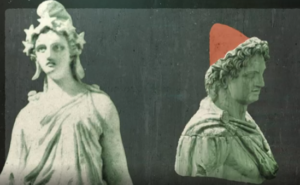
Jefferson Davis (who later became President of the Confederacy), a U.S. Senator and U.S. Secretary of War at the time, was charged with overseeing decoration of the Capitol. Davis rejected two original drawings with the liberty cap, considering it an affront to slaveholders.
Davis wrote, “its history renders it inappropriate to a people who were born free,” and not for people who are emancipated after experiencing slavery. A military helmet with an American eagle and crest of feathers replaced the cap. Today, many observers think the statue, with its eagle and feathers, to be Native American.
The original plaster model of the Statue of Freedom was shipped from Rome to the United States in five main sections. Upon its arrival, an Italian sculptor was hired to assemble the model. However, when the time came to move the plaster model from the Capitol to the foundry for casting, no one knew how to separate it and the Italian sculptor refused to help unless given a pay raise. Fortunately, Phillip Reid was there. He figured out that by using a pulley and tackle to pull up on the lifting ring at the top of the model the seams between the sections would be revealed. The statue was successfully separated into its five sections and transported to the foundry where it was used to make the mold for the final bronze statue.
In June 1860, casting of the Statue of Freedom began at Clark Mills’ foundry and lasted until 1862. This drawing by Thomas U. Walter, designer of the Capitol’s cast-iron dome, shows a section of the dome with the scaffolding used to erect the Statue of Freedom. On the right is the head being lifted into place on December 2, 1863. The event was marked by a 35-gun salute and answered by guns from the 12 forts that encircled the city during the Civil War.
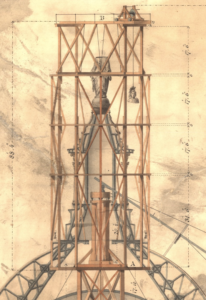
The statue, which stands 19 ½ feet tall and weighs approximately 15,000 pounds, depicts a female bearing a military helmet and holding a sheathed sword in her right hand and a laurel wreath and the shield of the United States in her left hand. She is draped with a robe and her dress is secured with a brooch with the letters “US.” She faces east toward the main entrance of the Capitol building and the rising sun. Ten spikes are attached to her headdress, shoulders and shield to keep birds from roosting there. The fact that the statue still stands is a testimony to the skill of Phillip Reid.
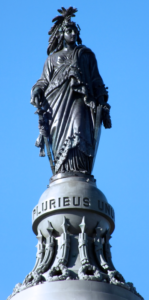
Phillip Reid received his freedom on April 16, 1862 when President Abraham Lincoln signed the Compensated Emancipation Act that released certain persons held to service or labor in the District of Columbia. He was 43 years old. After he was emancipated in 1862, Reid helped Mills during the moving and temporary placement of the bronze statue on the Capitol grounds. Reid was a free man when the last piece of the Statue of Freedom was put into place atop the Capitol Dome on December 2, 1863.
Author S.D. Wyeth wrote in The Federal City in 1865, “Mr. Reid, the former slave, is now in business for himself, and highly esteemed by all who know him.” Reid is buried in Graceland cemetery in Washington, D.C. with a view of the Capitol and the statue he helped to build.
The full-size plaster model of the statue, which was used to cast the bronze statue, can be seen in Emancipation Hall in the U.S. Capitol Visitors Center, where it has been on public display since 1993.
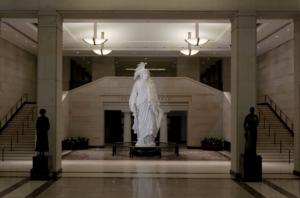
~ ~ ~ ~ ~ ~ ~ ~ ~ ~ ~ ~ ~ ~ ~ ~ ~ ~ ~ ~ ~ ~ ~ ~ ~ ~ ~ ~ ~ ~
While the Capitol has never before been the scene of mob violence, our country is not new to riots. Cities across this country—Cincinnati, Atlanta, Charleston, Chicago, Detroit, Tulsa, Wilmington (North Carolina), New Orleans, Memphis and Washington, D.C., to name just a few—have seen mobs storm Black neighborhoods wreaking havoc and leaving destruction and death. The Capitol insurrection, like the race riots of the 19th and 20th centuries, was fomented by hatred and fear, leaving targeted individuals living in fear. And like the race riots that mar our history, aggressors intended to effect change through terrorizing a constituency.
As painful as it is to remember the events of January 6, 2021, it is also painful to acknowledge that the U.S. Capitol, a symbol of our democracy, was built on the backs of men, women, and children brought to this country against their will and treated in the most inhumane ways. We cannot shed the story of that history any more than we can erase the images of the mob storming the Capitol last year. At the very top of the building that the insurrectionists chose to overrun and desecrate is the Statue of Freedom, built by a slave.